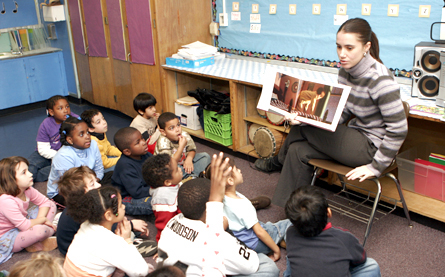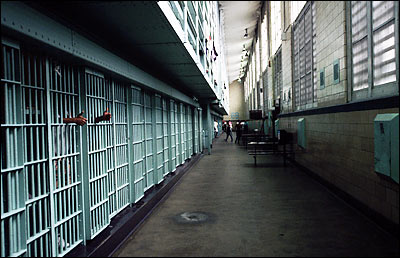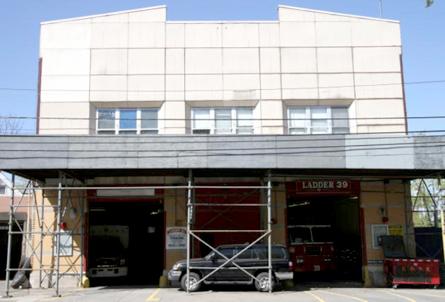The City's Resistance to Cutting Class Size

Mayor Michael Bloomberg and his Schools Chancellor Joel Klein have made sweeping changes in the city's schools, but the administration has ignored the number one concern of many parents, teachers and advocates: class size. A Newsday poll taken before the election found that class size remained the top education concern of voters. More recently, a Fordham online survey(in pdf format) of more than 500 parents and education advocates found that only 4 percent supported the mayor's education initiatives, while the overwhelming majority replied that his highest priority should be reducing class size.
This should come as no surprise. Smaller classes have repeatedly been shown to improve student achievement, cut down on teacher attrition, reduce disciplinary problems and increase parent involvement. While much of the focus on cutting class size has been on elementary grades, the overcrowded classrooms in many of our high schools have contributed to a state of perpetual crisis with rising drop out rates.
Today New York City’s classes remain the largest in the state by far. Though the Court of Appeals in the Campaign for Fiscal Equity case found that class sizes in New York City public schools were too large to provide children with their constitutional right to an adequate education, the mayor plans to spend only 2 percent of any money received as a result of the CFE suit to reduce class size. Instead, he intends to spend ten times as much on more administrators and specialists. On April 26, we will be in State Supreme Court to fight for the right of all New Yorkers to ensure that these funds are spent as the court intended.
This administration is undercutting the drive for smaller class size in six major ways.
1. FLOUTING STATE LAW
On March 16, State Comptroller Alan Hevesi, who has supported more state money for city schools, released his audit(in pdf format) of the city's use of over $500 million it has received from the state to cut class size since 1999. It found that as of last year, there were only 20 extra classes in kindergarten through third grade - not the 1,586 additional classes that education department officials claimed to have formed with state dollars. The comptroller also found that the city had sharply cut back the number of classes provided in grades K to 3 by almost 900 over the last four years.
If the Department of Education had actually formed the classes for which they had received state funding, the average class in the early grades would have 19.1 students. Instead, , despite declining enrollment, 65 percent of children in these grades remain in classes with 21 students or more, and 26 percent are in classes of 25 students or more.
 The comptroller concluded that the city was illegally charging the state for teachers who should have been paid for by the city.
The comptroller concluded that the city was illegally charging the state for teachers who should have been paid for by the city.
Though the findings of the audit were completed in July, its release was delayed for many months until the city provided a formal response. In a reply, dated November 7, 2005, the day before the mayoral election, Kathleen Grimm, deputy chancellor of finance and administration disputed the audit's methodology and conclusions, calling them overly "quantitative" and said the department would not change its practices.
While the state comptroller found there were schools with little room to form additional classes, he also found many that had the capacity, but had not received funds to add new classes or were not using the money appropriately. Moreover, there were elementary schools sitting only a few blocks away from each other, one overcrowded and with large class sizes, the other with plenty of room. But Grimm said there was no reason to change school boundary lines to address this.
2. TRYING TO KEEP THE VOTERS FROM DECIDING
Last year over 100,000 New Yorkers signed petitionsto put an amendment on the ballot that would require a minimum of 25 percent of the funds owed our schools as a result of the Campaign for Fiscal Equity case be spent on reducing class size to the levels elsewhere in the state, where classes are 10 to 60 percent smaller. This would allow voters to decide whether smaller classes should be required by law. But the administration has decided that this proposal is "improper" and should never appear on the ballot.
Why? The city makes the curious argument that the Department of Education is officially a state entity, and thus New York City voters can have no say when it comes to our public schools.
Taking this argument even further, the administration claims that Chancellor Joel Klein derives his authority over schools directly from the state, and thus no city law has any power over his actions. So the Department of Education refuses to comply with the anti-gay bullying lawpassed by the City Council or with regulations that require city agencies to use recycled paper.
In a recent case in which a parent sued the city for a slashing her child received at Evander Childs High School, the corporation counsel contended the city was not legally responsible, since the Department of Education was still under state control. The judge rejectedthe argument: "The Department of Education is a mayoral agency, just as are all the other city departments.” The city has appealed the decision.
Our coalition, New Yorkers for Smaller Classes, is contesting the administration's attempt to keep the charter amendment for smaller classes off the ballot. We are arguing that the chancellor and the Department of Education cannot be exempt from city law. A hearingis scheduled for April 26 in State Supreme Court.
Among the organizations submitting amicus briefs in support of the right of city voters to have a voice on this question are Citizen's Union (whose sister organization, Citizens Union Foundation, publishes Gotham Gazette), the NAACP, the Alliance for Quality Education, the Chancellor's Parent Advisory Council, and many other parent groups. Councilmember Robert Jackson and the Hispanic Federation are also intervening in support of our position and will be represented in court by Randy Mastro, former deputy mayor and head of a Charter Revision Commission under Giuliani.
3. CREATING FEWER NEW CLASSROOM SEATS
The following is the School Construction Authority's record of new seats created over the past four years, according to the Mayor's Management Report:
Fiscal year 2003 -- 22,267
2004 -- 12,921
2005 -- 8,631
2006 -- 4,287
There are fewer each year. (For a visual, see Class Size Matters.)
How many new seats were formed in the first four months of this fiscal year? Only 204. We are in danger of creating more seats in new stadiums than in schools during this administration.
And yet neighborhoods in all the five boroughs are experiencing a development boom, and it is now predictedthat the city's population will expand to more than nine million people by 2020.
In communities from Staten Island to the Bronx, large-scale housing and mixed-use projects are springing up - with no provision for all the additional students who will live in them.
In his State of the City speech, the Mayor bragged about the massive new developments, and boasted of a "sweeping inter-agency, five-borough Strategic Land Use plan that examines all of our city's neighborhoods and their needs for the 21st century, focusing particularly on housing, transportation, energy, and infrastructure – including parks." He made no mention of schools, the most chronically under-funded aspect of our infrastructure.
 Many of these projects would never be built without large tax breaks to the developers. We are about to give the Mets nearly $300 million in subsidies and tax exemptions, according to the Independent Budget Office, without asking that a single school be included in the project -- this in a neighborhood with some of the most overcrowded schools in the city.
Many of these projects would never be built without large tax breaks to the developers. We are about to give the Mets nearly $300 million in subsidies and tax exemptions, according to the Independent Budget Office, without asking that a single school be included in the project -- this in a neighborhood with some of the most overcrowded schools in the city.
But in other cities, developers of projects have to provide schools and other community projects. In school districts from Texas to California, developers are obligated to pay impact fees, to ensure that sufficient school space is provided to accommodate any increase in school enrollment because of their projects. In Miami, 20,000 new school seats have been created this year, with another 20,000 planned for next, in part by placing schools in new office buildings. This has enabled Superintendent Rudy Crew, who formerly headed the New York City system, to reduce class size in all grades. Unfortunately, in New York City, education is the forgotten stepchild of economic development.
Now that the city is expected to receive more than $9.2 billion for school facilities over the next five years, the capital plan needs to be amended so that it does what this specific figure was calculated by the court to achieve -- provide enough space to reduce class sizes in all grades through 12. In the current capital plan, the administration spends only one third of these funds on new capacity, with more money devoted to "restructuring" schools than building new ones.
The City Council should hold hearings to explore whether we can harness the development boom to our advantage, or whether our elected officials will stand on the sidelines as schools become even more overcrowded and another generation of students is doomed to failure.
4. THE MAYOR BREAKING HIS PROMISES FOR GOVERNORS ISLAND
When Michael Bloomberg first ran for mayor in 2001, he pledged to put high schools on Governors Island.
"We should build a major high school and university complex on Governors Island in partnership with one or more of our great private universities, he said on October 17, 2001. "The room is there for athletic facilities, laboratories, workshops, classrooms, etc. This would also free up many existing buildings in all boroughs for junior high school, elementary school and special education uses. "
Almost five years later, according to the mayor’s office, the city and state are “working on a plan to develop educational facilities on the site.” But no one in the administration seems to be talking about public school or CUNY classrooms on the island anymore. Instead, the Governors Island Preservation and Education Corporation, a joint city/state corporation, has been told to maximize the island's profit-making potential.
The facilities on Governors Island could have a significant impact on the city’s severely overcrowded high schools. According to the lease agreement, at least 20 acres of Governors Island have to be employed for education. Buildings that once held classrooms and would be perfect for high schools sit vacant, with sports fields adjacent, waiting to be used.
5. OPENING MORE CHARTER SCHOOLS
The mayor and his allies in the business world propose to create up to 100 new charter schools. Chancellor Klein has assured members of the City Council that he would not allow any new charter school to be created before it had an appropriate home. But the department's capital plancalls for 74 percent of them to be put in existing school buildings.
These actions will likely further overcrowd current public schools and raise their class sizes. Each new school gobbles up valuable classroom space for administrative and specialty purposes -- space that could be used to reduce class size instead. Already, a public school in Harlemand another on the lower East Side face the threat of larger classes as a result of the administration's intention to put charter schools into their buildings.
Of the 22 New York City public schools that currently share space with charter schools, only two did not see a significant increasein class size in at least one grade and usually many grades after a charter school was placed in its building.

The City Council ought to take the $100 million the mayor put into next year's budget for charter schools, and instead use it to improve outcomes for all our students, by reducing class size in our middle schools where test scores are flat or declining, and where children sit in classes of 28 or more.
6. INCREASING OUT-OF-CLASSROOM POSITIONS
There has been an explosion of out-of-classroom positions in our schools since the beginning of the Bloomberg administration. The headcount of bureaucrats at Tweed has mushroomed by 64 percent since 2003, only partly offset by a decline of administrators at the district level. Meanwhile, in 2005, the city comptroller found that there was a net loss of over 2,000 teachers in two years. "If dollars that are going directly to the classroom are not being invested in teachers, it begs the question: how was the money spent?" asked Comptroller William Thompson.
More recently, the Educational Priorities Panel (in pdf format) discovered that the percentage of spending devoted to instruction steadily declined during the first four years of the Bloomberg administration.
What are all of these people doing, what are they costing, and are they worth it? Would it be better to invest these funds on hiring more classroom teachers, so that class size could be reduced?
The City Council should take a serious look at these issues and take appropriate action to ensure that our children get the smaller classes they deserve.
Leonie Haimson is executive director of Class Size Matters. Â
Predicting The Unpredictable -- Planning Future Hospital Beds, Classrooms, Jail Cells Etc.

There were almost 900 patients waiting for care in hospital hallways or emergency rooms at one point in 1990 because the city's hospitals had more patients than they had beds for. Doctors said that hundreds more people avoided treatment altogether, knowing there was no room for them.
This was medical care during the height of the AIDS and crack epidemics.
Just four years earlier, though, the experts were saying that New York City's health care system was far too large. In 1986 a federally appointed panel said one in every seven hospital beds was unnecessary, and described any plan to expand or renovate a hospital as "outdated and probably unacceptable, whether it had been approved or not."
Obviously, the members did not know what lay ahead. But could they have? Should hospitals have planned differently? For that matter, how does anyone prepare for a future that is impossible to predict with certainty?
Strange, sometimes inexplicable, things are happening across the city. Crime rates are falling, yet the number of prisoners in city jails goes up. Public school enrollment has been dropping for years, yet many schools are increasingly overcrowded. “New York Is Losing People At Fastest Pace in America”, a newspaper headline screamed last week. But the city's population is at an all-time high.
There are different techniques for making sense of all this. To determine where to build or close fire stations, the city employs its own “complicated” but “non-mathematical” (and, critics charge, blatantly political) formula. To determine where it needs to build schools, it employs Eunice and George Grier, a husband-and-wife demography team working out of their home in suburban Maryland.
Those who run jails and hospitals have their own methods for predicting future needs, but their actions show how much faith they have in them. For years, the city has kept two empty jails around, just in case, and hospitals get nervous whenever more than 80 percent of their beds are full.
"You have to be respectful of the unforeseen," said Jim Tallon of the United Hospital Fund, acknowledging that the crack and AIDS epidemics developed "right under our noses" when he was head of the state assembly's health committee in the 1980s. "Things can occur that [you] didn't see coming."
JAILS: SETTING SPACE ASIDE
Between 1991 and 2004, the number of inmates in New York City jails dropped from 22,600 to 14,500, reflecting the monumental drop in crime throughout the city. The city, which was also facing budget problems, decided that it could get by with fewer jails.
"It didn't make financial sense to run your smaller operations at less than full strength when you have the ability to absorb that population into your main component," said Tom Antenen, a spokesperson for the Department of Corrections.
So the city closed three jails – one each in Brooklyn, the Bronx and Queens – and concentrated prisoners on Rikers Island. (A jail in downtown Manhattan and another in a barge docked in the Bronx remained open). Today almost nine of every ten inmates in the city are locked up on Rikers.
Keeping inmates together in one place allows for economies of scale, the city says. Also, because Rikers Island is so isolated, some of the inevitable conflicts with neighbors unhappy about living near a jail are avoided.

But there are costs as well. People generally appear in court in the borough where they were arrested. In addition, some attorneys are reluctant to make inconvenient trips to Rikers, so the city also brings inmates to courthouses to meet with them. Every year, city vans carry inmates to court dates and other appointments around the city. The cost, said the city's Department of Corrections, has gotten significant.
"We achieved some gains," said Antenen, but now the city makes tens of thousands of trips between Rikers and courthouses around the city. "That is an extra load we have to carry because we don’t have the borough jails."
There is some flexibility built into the jail system to account for predictable seasonal shifts (more people get arrested in good weather than bad, when they tend to stay inside and out of trouble). The city's Department of Corrections also predicts trends from year to year by examining crime rates, police arrest strategies, and the balance of felonies to misdemeanors (felonies take longer to process, so more felonies translates into a greater need for space) to predict its need for future space.
Crime rates are staying low, but lately there has been a spike in the number of inmates in city jails. Experts say the weather, while quite nice, cannot be completely to blame. Like many criminal justice-related trends, the spike in inmates is somewhat of a mystery.
Planning for such an event, the city has kept space in several empty jails warehoused, the largest being the 800-person Brooklyn House of Detention on Atlantic Avenue. Keepign reserve jail space is common for cities "hedging their bets", said Robert Gangi of the Correctional Association of New York State, a prisoner advocacy group.
But doing so isn't popular. Even though the city bore little direct financial cost from keeping the Brooklyn jail empty, community activists and local elected officials protested throughout its hibernation. They complained that the city was wasting money by renovating it, and depriving the community of a potentially valuable piece of real estate.
Now the Brooklyn jail may be reopened, as part of a plan that Mayor Bloomberg has described as a way to "share the pain", shifting back away from the supposed efficiency of keeping almost everyone at Rikers. People may not like it, but the city says the only thing that needs to be done to prepare the empty jail is to give it a good cleaning.
SCHOOLS: IGNORING THE SIGNS?
 From their home in suburban Maryland, Eunice and George Grier examine birth statistics from the city's Department of Health, analyze immigration trends, and track school enrollment for several different ethnic groups in each school district. For well over a decade, the city has contracted the husband-and-wife demography team to track long-term enrollment trends. The journal School Planning and Management recently praised the Griers for being "extraordinarily accurate."
From their home in suburban Maryland, Eunice and George Grier examine birth statistics from the city's Department of Health, analyze immigration trends, and track school enrollment for several different ethnic groups in each school district. For well over a decade, the city has contracted the husband-and-wife demography team to track long-term enrollment trends. The journal School Planning and Management recently praised the Griers for being "extraordinarily accurate."
Due to the end of the "baby boom echo" and a slowdown in immigration, New York City schools will have 110,000 fewer students by 2014, predict the Griers (in pdf format). The slowdown, which has been going on for several years, is only the latest turn in a series of rises and falls throughout the history of the city's schools.
New students poured into the system as the baby boomers began attending school in the 1950s, but enrollment then dropped for most of the 1970s and early 1980s as many parents moved out of the struggling city. After hitting a low in the early eighties, there was sustained growth until 2000, spurred first by the children of baby boomers, and then by those of new immigrants.
While the broad outlines of these trends are identifiable, predicting their twists and turns is hardly an exact science. In the late 1990s, the Griers were predicting that enrollment would begin dropping, but not until 2002. Between 2000 and 2002, they said, enrollment would increase by 6,000 students. But the downturn came in 2000, and over the next two years school rolls shrank by 10,000 students.
The New York City schools are particularly challenging for demographers, say the Griers, because of its size and because enrollment is tied closely to immigration, which is hard to project because it is affected by future federal policies and turmoil in foreign countries. The city's new focus on charter schools, which don't have to report demographic data as thoroughly, they say, is an added challenge.
But effective planning depends not only on what is happening in the school system as a whole, but what is happening in individual neighborhoods around the city. While enrollment numbers are dropping citywide, some areas – like Lower Manhattan and the Upper East Side – are actually expected to see their numbers rise.
For obvious reasons, neighborhoods don't want to hear they are losing students. Some local public officials criticize the Griers predictions of decline in neighborhoods like Fort Greene, Williamsburg and Greenpoint, citing plans for large-scale residential development. The Griers respond by saying that the impact of developments like the Atlantic Yards project are too uncertain to be taken into account today because they are still subject to major changes due to the political process. Until more is known about such developments, they say, it is unclear how many of the new developments' residents will attend public school.
Planning and Politics
"We don't get involved with policy, and we shouldn't," said George Grier. "That's for the politicians."
Of course, officials take more into account than the sober predictions of demographers when forming school policy.
To date, say experts, New York City has failed to provide adequate capacity in its school system. Three out of four high school students attended overcrowded schools in the 2002/2003 school year, according to a report by the Independent Budget Office. The city's recent focus on small schools exacerbates this problem, some say, because it means using scarce space in public school buildings to serve a relatively small number of students.
Lowered enrollment gives the city the opportunity to catch up, said the Independent Budget Office.
Noreen Connell of the Education Priorities Panel says the city has a series of tools at its disposal to confront overcrowding. Most obviously, it could build new schools. But shifting the borders of school districts or lease existing space could be cheaper ways to do the same thing.
The failure to implement such solutions, say city officials and education advocates, is based largely on the lack of funding from Albany. This has been the subject of the long-running Campaign for Fiscal Equity lawsuit. In February, the mayor said that the goals of the current capital plan would not be met if Albany didn't pitch in.
The state has been resistant to increasing funding to city schools, even after courts have ruled that it must. But as part of this year's budget, Albany laid out a five-year plan to dedicate $11 billion for school construction, the Campaign for Fiscal Equity's estimated amount of how much it would cost for New York City to build the schools it needs.
With the resources suddenly available, the city has the freedom to make decisions on planning based more on what the system actually needs, say advocates, but it needs to step up and do so.
"They need a long term plan to create the capacity so that all the kids in New York City can go to uncrowded schools with smaller classes," said said Leonie Haimson of Class Size Matters. "They actually have the potential to do this." [Read this week's Commentary, "Keeping Classes Large" by Leonie Haimson for more]
THE FIRE DEPARTMENT: ADJUSTING TO A CHANGING JOB
Facing a budget squeeze in 2003, the mayor's office used a "complex" but "not mathematical" formula that took into account response times to fires, population density, and the locations of firehouses around the city. It determined that it could close six firehouses – four in Brooklyn, one in Manhattan, and one in Queens – without harming fire department's ability to do its job.
Three years later, the time it takes the department to respond to fires has increased, even as the closings have not allowed the department to cut costs (in pdf format). But even many critics of the closings agreed that the fire department needed to be restructured accordingly. So what went wrong?
It is true that in some ways the job of the fire department is getting easier. Despite a growing population, New York has fewer fires (in pdf format). Sprinklers and better fireproofing have made buildings safer. And the city has developed more efficient ways to deploy fire trucks to emergencies around the city.
What has changed is what kinds of emergencies those trucks are being sent to, and critics say that the city failed to take into account what the fire department actually does. While the fire department may respond to fewer fires, it has an increasing amount of other duties, including providing emergency medical services, clearing sites of hazardous materials, and investigating carbon monoxide alerts.
But when the city studies its capacity, it relies on data collected in the 1970s when fighting fires was still the major task of the department, said Vincent Dunn, a retired deputy fire chief. It doesn't look at the department's other tasks. Dunn and others, like the Citizens Budget Commission, which studied the department extensively in the 1990s, say the city needs to review the way it looks at response times in a way that takes the changing nature of firefighting into account.
"It's not your grandfather's fire department anymore," said Charles Brecher of the Citizens Budget Commission.
The city's approach has allowed it to improve its performance in some places. Rapidly growing Staten Island was suffering from the biggest slowdown in fire response until 2004, when a new fire station and emergency medical service station was built. Since then, Staten Island has been the only borough to see reduced fire response times.

Woodlawn firehouse (photo by Susan Sipprelle)
Meanwhile, the city recently announced plans to close another fire station – the Woodlawn firehouse in the Bronx. Jeff Klein, the local state senator who has studied how closings have affected response times citywide (in pdf format), complains that the city continues to use flawed analysis to determine which areas can get by with fewer fire stations.
"The money saved means nothing compared to the lives lost," he said.
HOSPITALS: PLANNING FOR THE UNPREDICTABLE
There is currently a good deal of momentum to restructure the health care system in New York State, a process that state officials and hospital industry groups agree may include closing hospitals. A state commission has been appointed to look into "right-sizing" the health care system, which is seen to be in bad shape financially.
Some worry, however, that these discussions are neglecting the health care system's ability to respond to future disasters.
"I don't think it's a different situation now [than in the mid-1980s]," said Judy Wessler of the Commission on the Public Health System, a group opposing hospital closings. Shutting down hospitals, she said, "will totally throw out our ability to deal with any surge capacity or need."
Surge capacity refers to a hospital's ability to respond to sudden increases in the need for medical attention. It may include quickly providing extra bed space, bringing on extra staff, discharging current patients to accommodate new ones, or even setting up temporary wards to handle large numbers of ill or injured people. Plans generally include cooperation between competing hospitals.
Some surges, like flu season, are somewhat predictable. For day-to-day planning said Tallon of the United Hospital Fund, hospitals try to stay between 75 and 80 percent capacity. New York hospitals operate within that range he said, but they are running significantly closer to capacity now than they were two years ago.
 Other surges, like hurricanes or terrorist attacks, are not predictable.
Other surges, like hurricanes or terrorist attacks, are not predictable.
Concerns about dealing with these kinds of disasters have always been around, but have been increased by 9/11, the failure of the response to Hurricane Katrina, and continued fears about bio-terrorism and bird flu. Some see surge capacity around the country as inadequate.
New York's health care system does have plans for future disasters. In order to get federal funding, the state meets requirements to be prepared to accommodate a surge of 500 patients for every million in population within three hours. About 75 percent of the state's hospitals say they have specific plans to deal with bio-terrorism (in pdf format).
Reserving the capability to respond to large-scale disasters is expensive, and the financial viability of the health care system in its current form in question. Currently, there is a debate among the Commission on Health Care Facilities, the panel looking to "right size" the state's health care, and health care advocates about how much extra space the system has – and how to reserve the surge capacity it needs.
"It is not possible to have the beds, staff and equipment in place at all times to meet the most extraordinary demands that are every likely to face the system," the commission wrote in a report published in February.
It is unclear how the commission is considering surge capacity among its priorities, but groups like the Healthcare Association of New York State have expressed concern.
"How can we balance our ability to deal with the potential disaster versus the state's ability financially to run the system on a daily basis," said William Van Slyke of the Healthcare Association of New York State. "That's a tough thing."
Susan Sipprelle contributed to this article.Â
Buildings, But How About Books?
Is the end actually in sight?
Speaking to reporters on April 18, Michael Rebell, a lead attorney for the Campaign for Fiscal Equity, said the case seeking billions more in funding for New York City public schools could be drawing to a close.
The journalists listening might be forgiven for skepticism. The CFE case, as it is commonly known, has involved lawyers, politicians, educators and various wonks for 13 years. It began shortly after Rudolph Giuliani became mayor, as the Board of Education (now the Department of Education) struggled to find a new schools chancellor to replace ousted Joseph Fernandez (four chancellors ago), and when Robert Jackson served on a community school board in Manhattan. (He is now a member of the City Council, and heads the council’s education committee.)
Jackson and Rebell, frustrated by the shortages confronting that school district, launched the lawsuit in 1993. Since then, it has meandered its way through the court system and loomed over city and state budgets and decisions about school funding.
The last several weeks have seen more twists and turns, including the latest legal maneuver by Campaign for Fiscal Equity -- this one designed, it says, to force the city finally to ante up billions for city schools.
VICTORY FOR SCHOOL CONSTRUCTION, BUT...
This action comes in the wake of a substantial victory for school advocates -- a plan to get billions more for school construction in the city. But Governor George Pataki and the state legislature continue to resist providing billions more in operating funds for city schools. That resistance spurred the latest CFE action.
In his February, 2005, ruling in the CFE case, Judge Leland DeGrasse called for the city to receive an additional $5.63 billion in operating funds per year (on top of the existing budget , which is currently about $15 billion) in order to give all of its 1.1 million public school students “a sound, basic education.” He also said the schools would need an additional $9.2 billion for adding and improving facilities over a five-year period.
In late March of 2006, the legislature agreed to a plan that would provide the city with $11.2 billion for school construction over the next five years. But the legislature provided only $400 million in additional aid for operating expenses, prompting the latest CFE appeal.
THE CAPITAL FUNDS
When the year started, the two sides in the school funding dispute appeared as far apart as they had ever been. Pataki’s 2007 budget continued his policy of what his critics would call thumbing his nose at -– or, as his staff would put it, appealing –- the court ruling. He provided no funding for capital projects and boosted aid to New York City schools by $329 million – far short of the billions called for in the ruling.
For years, Mayor Michael Bloomberg, while saying the schools needed infusions of money from Albany, had been loathe to take on Pataki or the legislature. The mayor wanted the governor’s support for the ill-fated West Side stadium, some theorized; others thought he did not want to take on a fellow Republican. And some said Bloomberg preferred negotiating behind the scenes to making contentious public pronouncements.
But Bloomberg’s reticence faded after his re-election in November. In February reports began circulating that the mayor might work for the election defeats of key Republican state senators to punish them for not backing more school aid for New York City.
And then the mayor visited another plague on the recalcitrant politicians. The city has a five-year $13 billion plan (in pdf format) to build and improve school facilities. The city and state were supposed to share the tab. When Pataki did not come up with the state’s portion, Bloomberg announced he would be cutting 21 projects, targeting ones in key legislators’ districts. "We picked the schools where the people in Albany have some power," Bloomberg reportedly said in late February. "They're really not going to get away with this anymore."
Apparently not. Under the complex borrowing arrangement hammered out by the legislature, New York City would get $11.2 billion in school capital funds over the next five years. This would allow the city to restore the 21 threatened projects as part of its overall plan to construct or lease 76 additional school buildings, make repairs to old schools, improve science labs and provide for other renovations.
Although the state legislature and Pataki remain far apart on the overall state budget, the school funds appear safe. Pataki vetoed 202 items totaling about $3 billion in the legislature’s budget for fiscal year 2007, but did not touch the $11.2 billion for school construction or the additional operating money.
GODSEND OR GIMMICK?
School advocates have hailed the additional money for construction and improvements. “We’re very pleased,” said Noreen Connell, executive director of the Educational Priorities Panel. While “in an ideal world the legislature would have complied with the whole court decision,” she said, it makes sense to focus on physical improvements first. “You can’t reduce class size without new classrooms.”
Bloomberg commended the deal as an “excellent agreement” and applauded the “real and impressive leadership from Speaker Silver and Majority Leader Bruno, who rolled up their sleeves, got to work and found a way to deliver for our students."
But the funding plan worries some fiscal experts. The first part of the money – about $1.8 billion – would come from funds the state would borrow from the State Dormitory Authority. The rest -- up to $9.4 billion -- would come from borrowing done by the city through another public authority, the Transitional Finance Authority. The state would guarantee the new bonds and agree to provide enough future funding to sustain the bonding program.
Why such gyrations? The city and state governments themselves cannot borrow the money because of restrictions on government borrowing. Most importantly, the voters would have to approve it – and they might balk. After all, voters rejected a school bond act in 1997. But borrowing through the public authorities -- backdoor borrowing as critics call it -- avoids such pitfalls.
“It’s gimmicky,” Connell said. “But Albany is gimmicky.”
“This points out the need for debt reform,” said Elizabeth Lynam of the Citizens Budget Commission, a watchdog group. While agreeing that the schools need physical improvements, she said, “From the state’s perspective, it’s not a great deal because it’s going to add to the state’s debt, which is already jeopardizing the health of the state.”
THE OPERATING FUNDS
Some education advocates have concerns too. The Campaign for Fiscal Equity, in particular, charges the legislature and governor continue to flout the court’s ruling calling for additional billions to pay teachers and provide supplies. "Our schools need operating monies desperately,” CFE executive director Geri Palast has said, “and we will continue to press the case until the court-mandated operating aid starts to flow and the constitutional violation at the heart of our case is fully corrected."
And so the group has asked the state’s highest court, the Court of Appeals, to force the state to ante up. In its appeal, CFE requests an expedited hearing so the city can begin to see the additional money by the next school year. It wants the court to issue a clear order that the state must begin giving billions more to the schools. If the state still refused to act, the courts could impose sanctions, Rebell said.
The sanctions spring from one of the main frustrations of those fighting for more money for schools. Although the courts have repeatedly ruled in favor of increased funding, the state has dragged its feet, failing to address the issue in its budgets and continuing to file appeals. “The failure of the governor and the legislature to respect a clean mandate of this court...substantially undermines the rules of law and public respect for court orders,” the Campaign for Fiscal Equity said in its appeal letter. Now, the group hopes finally to get the money and, it says, end the case.
But it won’t be that simple. After the campaign announced its appeal, Pataki spokesman Scott Reif told the Albany Times-Union that the state might take legal action of its own. "The state's attorneys are reviewing whether we now need to file a cross-appeal to protect the state taxpayers' rights in light of today's unexpected action by CFE," he said.
The Campaign for Fiscal Equity’s request comes after another court decision -– this one in late March –- did little to clarify matters. The ruling by the Appellate Division, the court that has been most hostile to CFE’s arguments, left much room for interpretation. It said, on the one hand, that New York City schools need at least $4.7 billion a year more in state aid than they now get and another $9.2 billion in capital funds over the next five years. And, the judges said, the 2007 budget should reflect this. But then the court, by a 3-2 vote, went on to say that only the governor and the legislature, not the courts, could determine the exact amount of education aid.
Both sides declared victory. Governor George Pataki hailed the decision for reaffirming “the longstanding constitutional principle of separation of powers.” The Campaign for Fiscal Equity on the other hand, cheered too: “The court brushed aside the governor’s latest appeal, ruling that it is â€undisputed’ that the state has failed to appropriate the amount of funding needed to meet the CFE mandate.”
Calling the decision “poorly drafted mind-blowingly muddled,” E.J. McMahon, director of the Manhattan Institute’s Empire Center for New York State Policy, wrote, “With his gift for ambiguity [Presiding Justice John] Buckley has done his part to ensure that all the lawyers involved in this case will be busy for years to come.”
Given the history of this case -- and the painfully long battles over school funding in other states -- McMahon could well be right.
Â




